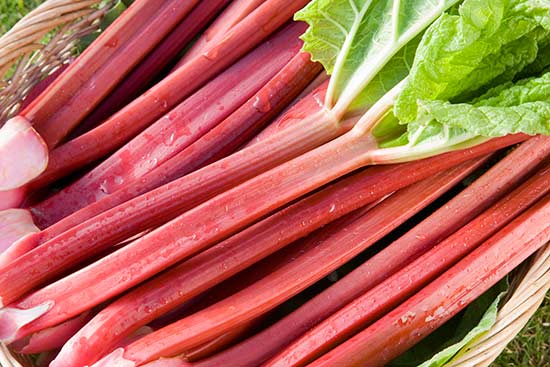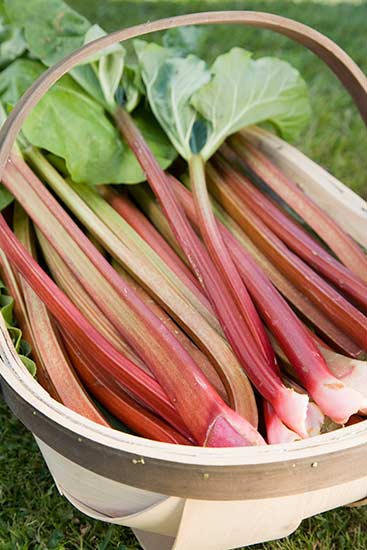For some reason the word rhubarb always seems to generate laughs whereas the reality is that it is a very fine vegetable which is well suited to growing in the garden. But is it a vegetable or fruit? This is always a very interesting question. The vegetable growers and both the RHS and National Vegetable Society classify rhubarb as a vegetable but it is always used as a fruit in this country. For various reasons a New York Court in 1947 decided it is a fruit and therefore ever since then rhubarb has been classified as a fruit in the USA. But I digress!
Rhubarb is easy to grow in the garden and grown well it should be possible to produce a reasonable quantity of stalks between March and October although protection will be required at any cold times.
So what actually is rhubarb? It is an attractive (and can be grown for decorative purposes alone), hardy perennial with large leaves and pink, red or greenish red leaf stalks that are used as a dessert, often in pies and crumbles. Stalks are usually picked in spring, summer and early autumn but plants can be covered to produce an early or late crop of blanched stalks in early spring or late autumn. The flavour of the stalks varies in sweetness depending on the age of the stalks and the variety.
Rhubarb can be grown anywhere in the garden from borders to vegetable plots but really needs an open, sunny site with moist, but free-draining soil as the plants hate being waterlogged in winter. Avoid frost pockets if possible as stalks are susceptible to frost although this isn’t critical as it is only the early stalks that will be affected. Rhubarb can also be grown in pots and containers where space is limited but they will need to be quite large and at least 50cm (20in) wide and deep. The drawback with rhubarb grown like this is that you will need to do plenty of watering in dry periods.
The most sensible and practical way of planting rhubarb is to plant dormant crowns between late November and March. For long life and good production of stalks from the plants the ground should be thoroughly prepared by double digging incorporating a good quantity of well-rotted organic matter such as manure or home produced compost. When planting make sure the tip of the crown is just visible above the soil and add a handful of Rootgrow mycorrhizal fungi before backfilling. Space plants 75-90cm (30-36in) apart, with 30cm (12in) between rows if you are growing more than one plant. Pot and container grown rhubarb can be planted at any time, but will need plenty of water during dry spells.
To help keep your rhubarb plants free from weeds, cover the ground with a mulch of well-rotted organic matter, but do not bury the crown as it will rot. A good handful of bonemeal or blood, fish and bone applied in March will benefit your plants tremendously as will watering regularly in dry spells to keep the ground moist thereby actively encouraging plant growth until autumn. When the top growth dies back in autumn, remove the dead leaves to expose the crown to frost – this will help break dormancy and ensure a good crop of stalks the following year.
To get an early or late crop, you can force stalks. You can do this by covering the crown with a traditional forcing jar, bucket or upturned pot in late winter or early autumn, ensuring that all light is deprived covering any drainage holes. Check regularly and when stalks reach the top of the cover, they are ready for harvesting; forced stalks are lighter and more tender than those grown in the light. Do not keep covers on all year round as the plants will not survive for long if deprived of light all year.
Do not harvest your rhubarb in the first year after planting as the roots of the plants need to establish a good strong plant; early harvesting will seriously affect future vigour. You can cut a few stalks the next year, then up to a third or half from then on, leaving some to keep the plant in active growth. To remove, hold the stalk at the base and ease it out of the ground, aiming to avoid snapping it off. Although rhubarb stalks remain palatable and usable through summer, it is best not to over crop the plant and cease pulling by June, or at least only remove a few stalks after then.
There are quite a few varieties of rhubarb around but I thoroughly recommend those listed below. As ever, I advise you to only buy your plants from a reputable source as you will get the best quality plants and plants which are guaranteed to have a long life.
Champagne – an old variety that has long scarlet red stalks with a pinkish red flesh. The flavour is very good indeed and it is a very reliable cropping plant. It has a very long season and is very useful for forcing.
Raspberry Red – produces thick, deep red stalks which have a very sweet flavour. The stalks are produced early in the season which can preclude the need for forcing to achieve an early crop. This variety has been awarded an Award of Garden Merit (AGM) by the Royal Horticultural Society.
Timperley Early – one of the earliest rhubarb varieties which can be ready without forcing as early as February. It is also suitable for forcing if you want to produce an even earlier crop and will provide you with succulent, red-based pink stems with a delicious flavour. (AGM)
Livingstone – this is the first rhubarb to be particularly bred for autumn stalk production. The stalks are thick and pinkish red to look at and will be produced from late August to November without any need for forcing.
Gerry Edwards
15th January 2014
Gerry is an experienced amateur fruit grower who is Chairman of the RHS Fruit Group, a member of the Royal Horticultural Society’s Fruit, Vegetable and Herb Committee and also their Fruit Trials Panel. Gerry judges fruit nationally for the Royal Horticultural Society and is also a qualified National Vegetable Society judge.



great and easy to follow instructions a good read. LPASSO
Hi gerry, I’d like to ask you, will this newly bred Livingstone rhubarb cultivar produce viable seeds, to grow true to parent? And what about the Timperly Early? thank you for your answer
Rhubarb seed will not come true to type. Some are better than others (like Victoria) but even that isn’t perfect.